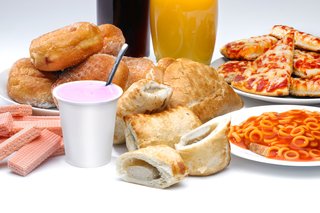What Do Processed Foods Do to Your Body

Processed foods are not just microwave meals and ready meals.
A processed food is any food that has been altered in some way during preparation.
Food processing can be as basic as:
- freezing
- canning
- baking
- drying
Not all processed foods are unhealthy but some processed foods may contain high levels of salt, sugar and fat.
What counts as processed food?
Examples of common processed foods include:
- breakfast cereals
- cheese
- tinned vegetables
- bread
- savoury snacks, such as crisps, sausage rolls, pies and pasties
- meat products, such as bacon, sausage, ham, salami and paté
- microwave meals or ready meals
- cakes and biscuits
- drinks, such as milk or soft drinks
Not all processed food is a bad choice. Some foods need processing to make them safe, such as milk, which needs to be pasteurised to remove harmful bacteria.
Other foods need processing to make them suitable for use, such as pressing seeds to make oil.
What makes some processed foods less healthy?
Ingredients such as salt, sugar and fat are sometimes added to processed foods to make their flavour more appealing and to extend their shelf life, or in some cases to contribute to the food's structure, such as salt in bread or sugar in cakes.
Buying processed foods can lead to people eating more than the recommended amounts of sugar, salt and fat as they may not be aware of how much has been added to the food they are buying and eating.
These foods can also be higher in calories due to the high amounts of added sugar or fat in them. Find out more about calories.
How can I eat processed foods as part of a healthy diet?
You have no control over the amount of salt, sugar and fat in processed food but you do have control over what you to choose to buy.
Reading nutrition labels can help you choose between processed products and keep a check on fat, salt and sugar content.
Most pre-packed foods have the nutrition information on the front, back or side of the packaging.
If the processed food you want to buy has a nutrition label that uses colour-coding, you will often find a mixture of red, amber and green.
When you're choosing between similar products, try to go for more greens and ambers, and fewer reds, if you want to make a healthier choice.
There are guidelines to tell you if a food is high or low in fat, saturated fat, salt or sugar.
The guidelines, which are for adults, are:
Total fat
High: more than 17.5g of fat per 100g
Low: 3g of fat or less per 100g
Saturated fat
High: more than 5g of saturated fat per 100g
Low: 1.5g of saturated fat or less per 100g
Sugars
High: more than 22.5g of total sugars per 100g
Low: 5g of total sugars or less per 100g
Salt
High: more than 1.5g of salt per 100g (or 0.6g sodium)
Low: 0.3g of salt or less per 100g (or 0.1g sodium)
If you are trying to cut down on saturated fat, try to limit the amount of foods you eat that have more than 5g of saturated fat per 100g.
Red and processed meat can be high in saturated fat. We are advised not to eat more than 70g a day.
If you're pregnant, find out what food you should avoid.
When cooking food at home...
For tips on how to eat healthily on a budget, read our healthy recipes and check out our tips to eat well for less.
Page last reviewed: 10 January 2020
Next review due: 10 January 2023
What Do Processed Foods Do to Your Body
Source: https://www.nhs.uk/live-well/eat-well/what-are-processed-foods/
0 Response to "What Do Processed Foods Do to Your Body"
Post a Comment